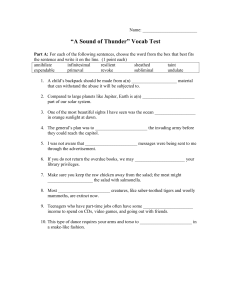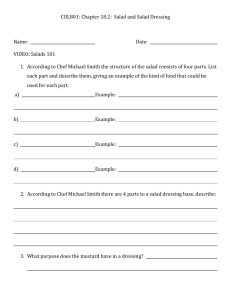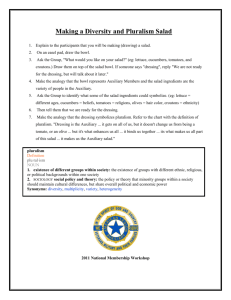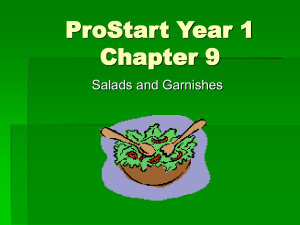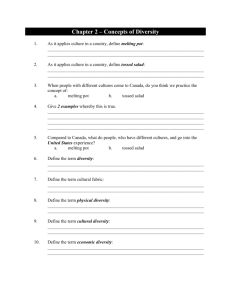Salads
advertisement
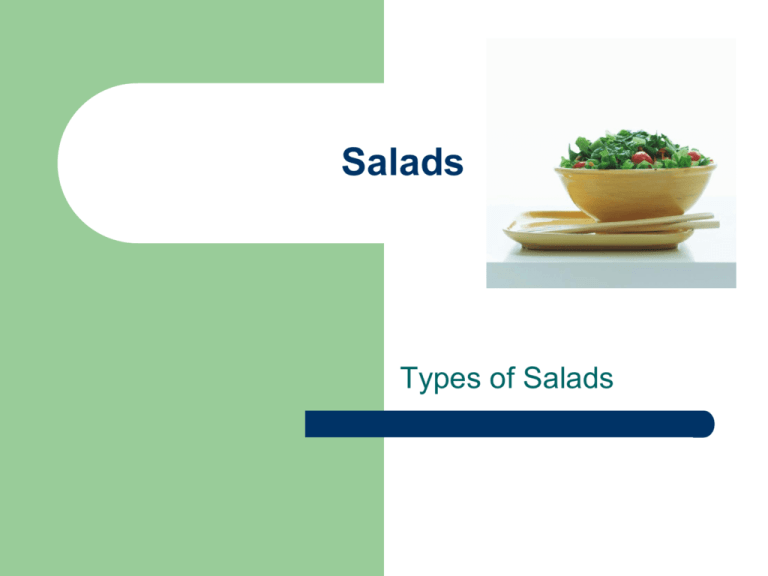
Salads Types of Salads 3 Types of Salads Simple Salad – one main ingredient – – Complex – – Usually the lettuce Tossed salad is the best example More than one main ingredient Think chicken salad Composed salad – – This is a salad that is plated on purpose They are arranged instead of tossed Classic Cobb Salad You will be making a Cobb salad today. Substitute cucumber for the avocado. Course Types of Salads Appetizer Salad Stimulate the appetite Fresh, crisp ingredients Tangy, flavorful dressing Appearance is important so garnishes should be attractive Accompaniment Salads Light and flavorful Should complement and balance the meal Sweet fruit salads can accompany ham and pork Vegetable salads accompany hearty meal Heavier salads such as pasta should be served with lighter entree Main Course Salad Large enough to serve with as a meal Contain protein Well balanced meal both visually and nutritionally Variety of fruits and/or vegetables Separate course salad Cleanse the palate after a rich dinner and before dessert Served in classic French meals Must be very light Bibb lettuce with vinaigrette dressing Fruit salad Dessert Salad Sweet and often contain fruit, sweet gelatin, whip cream Too sweet to be served as accompaniment or appetizer Nutrients in a Salad Minerals and vitamins come made to order in the fresh fruits and vegetables found in salads. Salads provide plenty of bulk or roughage to aid in good digestion and preventing deceases. This regularity will help you grow stronger and more healthy and beautiful. The main course salads of eggs, fish, meat, poultry and cheese serve as body builders and provide protein for the body. Pasta and potatoes provide carbohydrates. Salads Parts of a Salad Base Usually a layer of salad greens that line the plate or bowl Romaine, chicory or loose leaf lettuce can be used as the base SALAD GREENS Iceberg - lettuce is by far the major type. Heads are large, round and solid, with outer leaves medium-green. Inner leaves are a lighter green. Butterhead - lettuce, including the Big Boston and Bibb varieties is a smaller head than Iceberg. It is slightly flat on top and has a soft, tender, pale inner leaves that feel oily or buttery. Romaine - lettuce plants are tall and cylindrical with crisp, folded, dark-green leaves. It is famous for it use in Caesar Salad. Leaf - lettuce has broad, tender succulent, fairly smooth leaves that vary in color depending on variety. How to Care for Salad Greens Crisp up greens by placing in ice water for a few hours before serving. Drain thoroughly before serving. Greens may be broken or shredded according to the purpose. Do not over handle or greens become bruised and wilted. Store in a plastic. Do not wash until your ready to use it as the greens might rust. Never freeze. Body The main ingredient Can be a mixture of vegetables, meats, and fruits Salad ingredients can vary by season or occasion but freshness is always important Garnish Adds color and appeal Simple garnishes are best Can be mixed with other ingredients or added at the end Examples include parsley, paprika, fresh cherry tomato Salad dressings Purpose is to moisten, flavor and enrich the food Tart or sour dressings work with greens and vegetable salads Slightly sweet dressings work with fruit Heavy dressings such as mayonnaise mixed with the salad are called bound salad Arranging Salads Look at the plate or bowl as frame. Pick the right size dish. Keep salad off the rim Maintain good balance of color Three colors is usually enough Height makes the salad more attractive Cut ingredients neatly and uniformly Be sure ingredients can be identified Keep arrangement simple Principles of Salad Making 1. 2. 3. 4. 5. 6. 7. Place on a chilled plate or dish at least 5 hours before serving. Prepare salad dressing 2 to 3 hours and chill. Make just before eating. Choose fresh and good quality produce. Salads should look neat, but not labored over. Handle greens as little as possible. Avoid too much dressing. Principles of Salad Making 8. 9. 10. 11. 12. 13. 14. Do not put the dressing on or salt salad until just before serving. Break or tear into bite-size pieces. Use no more than 3 -4 ingredients. Ingredients should be welldrained. Combine crisp with soft ingredients for contrast in texture. Toss with a fork to give the tossed rather than smashed appearance. Serve immediately.

